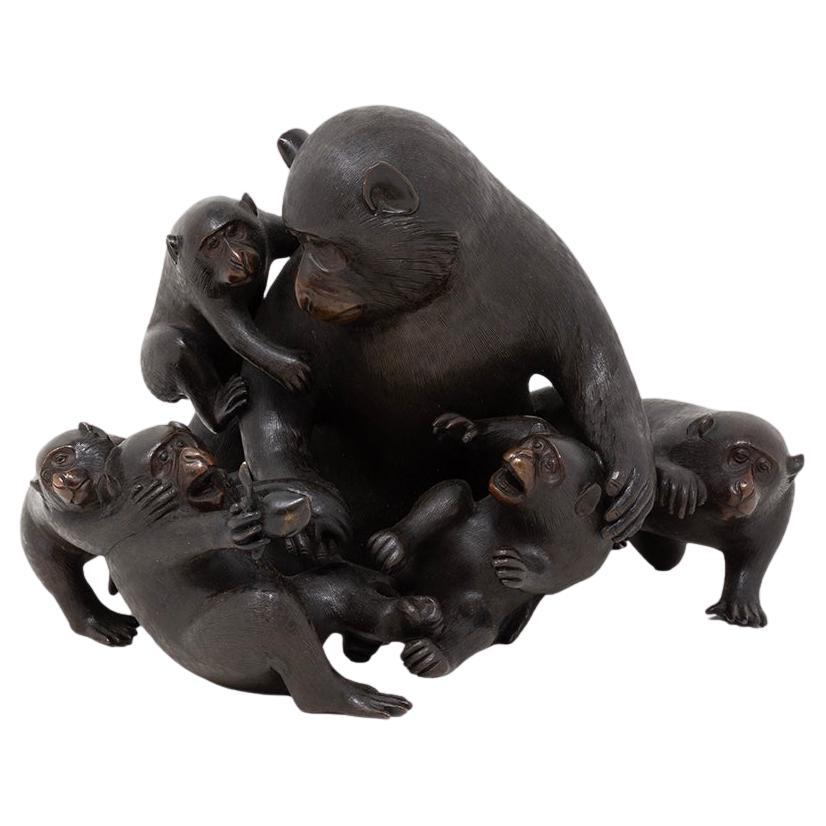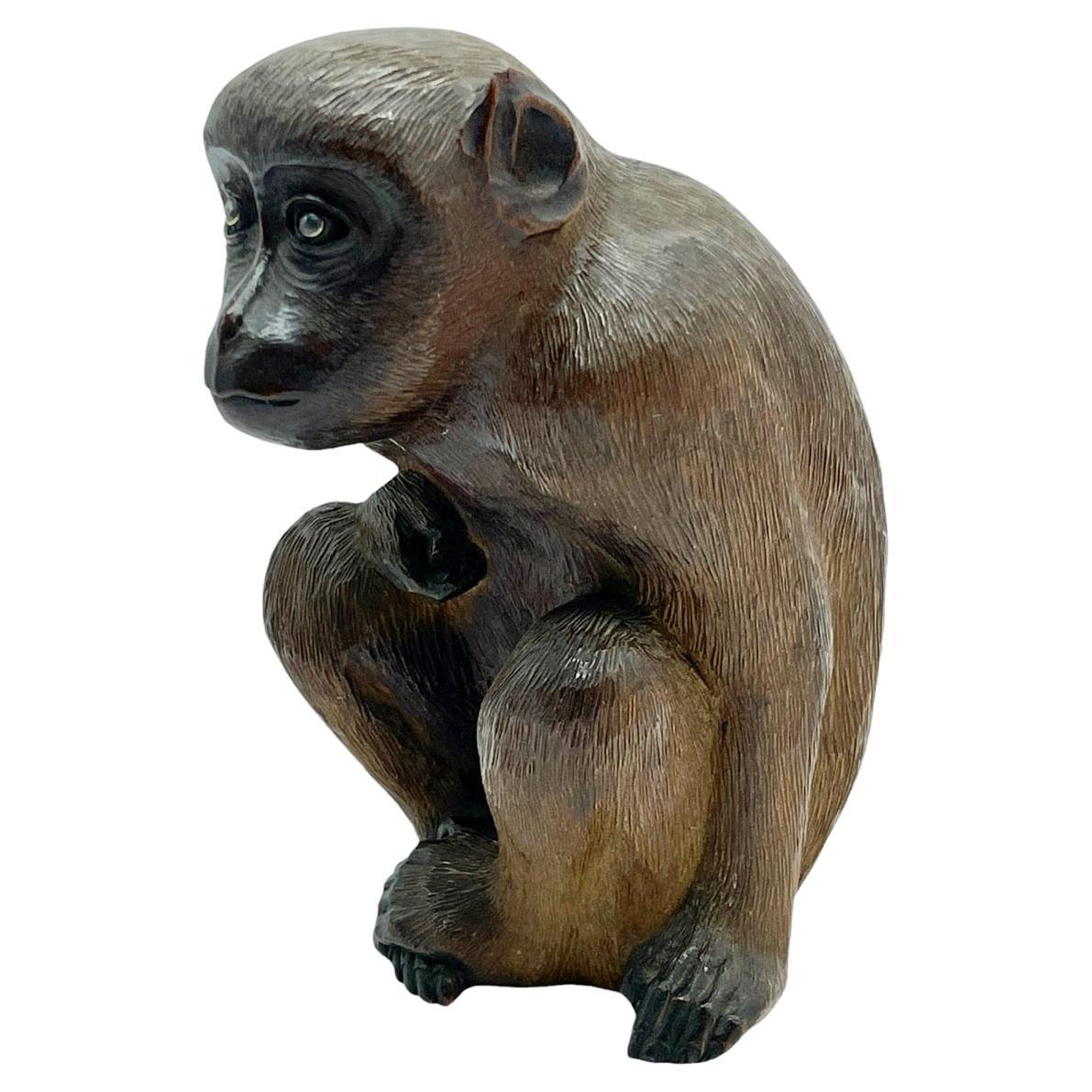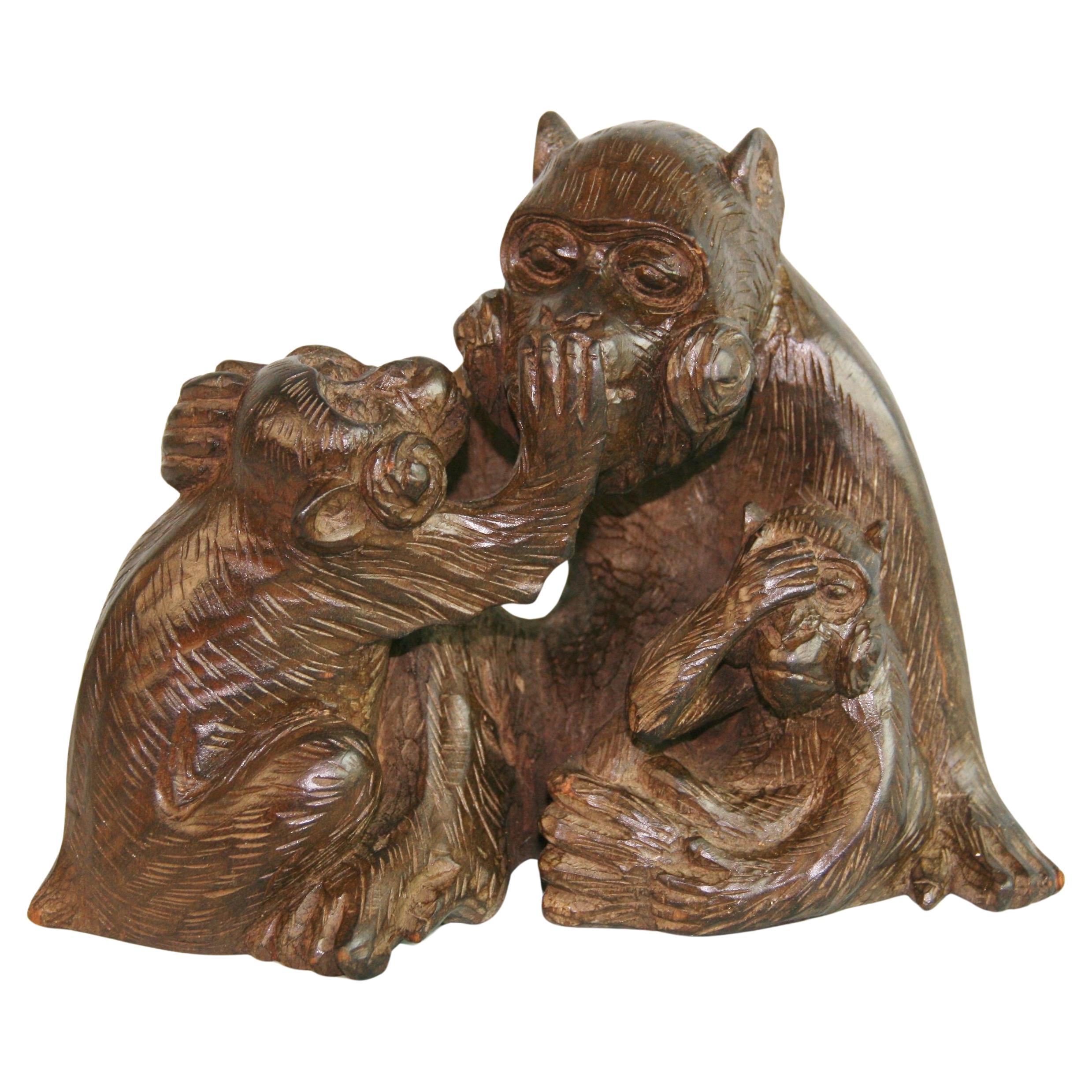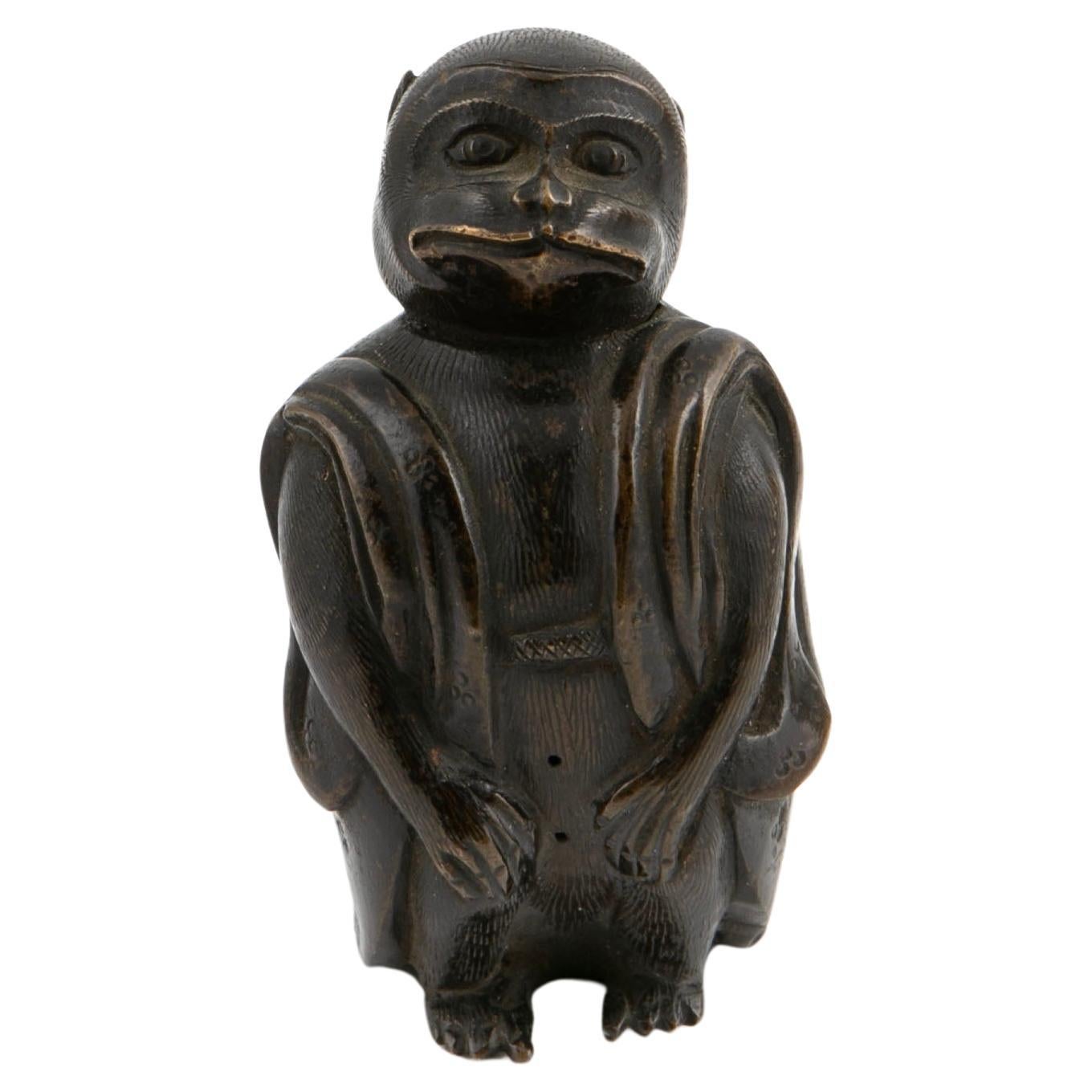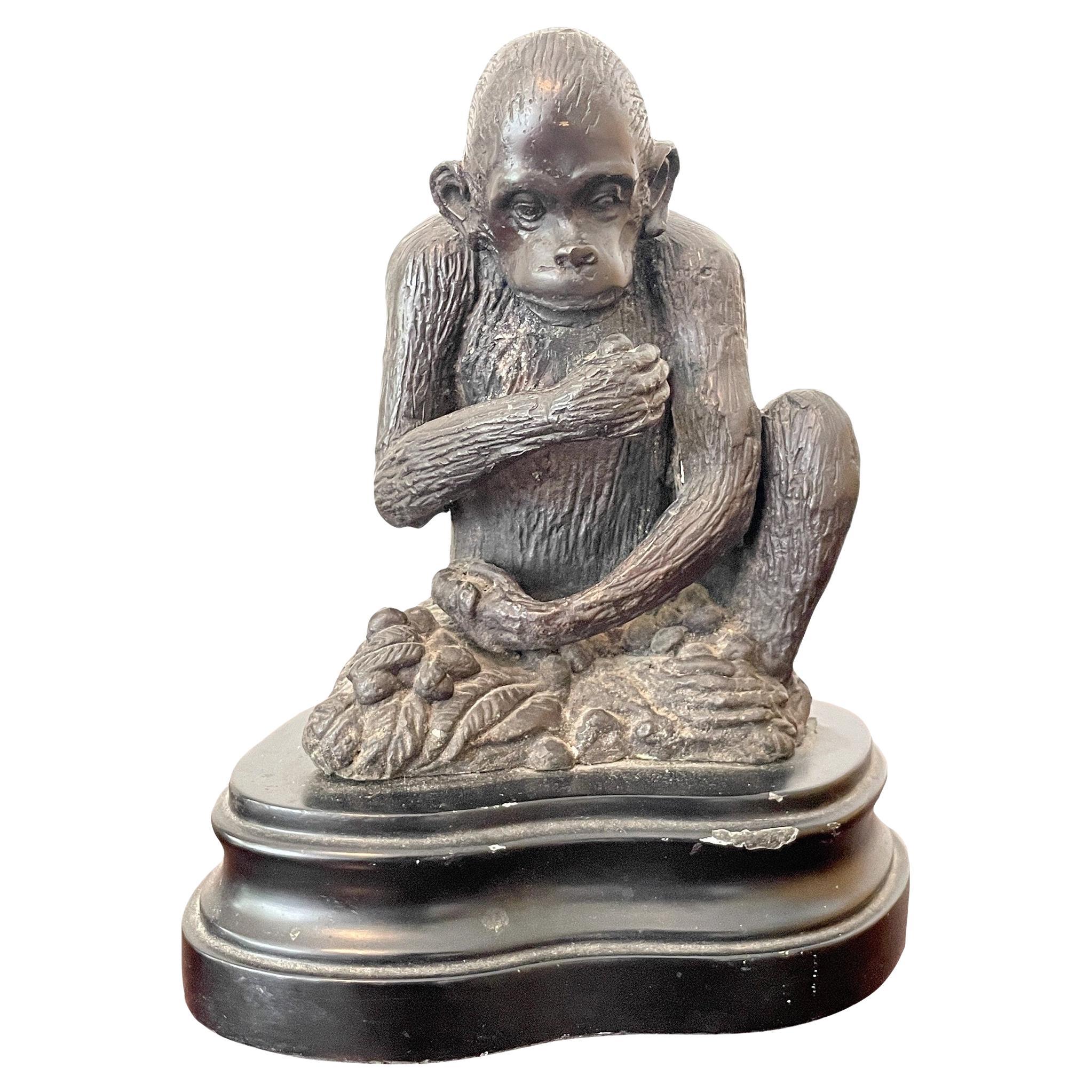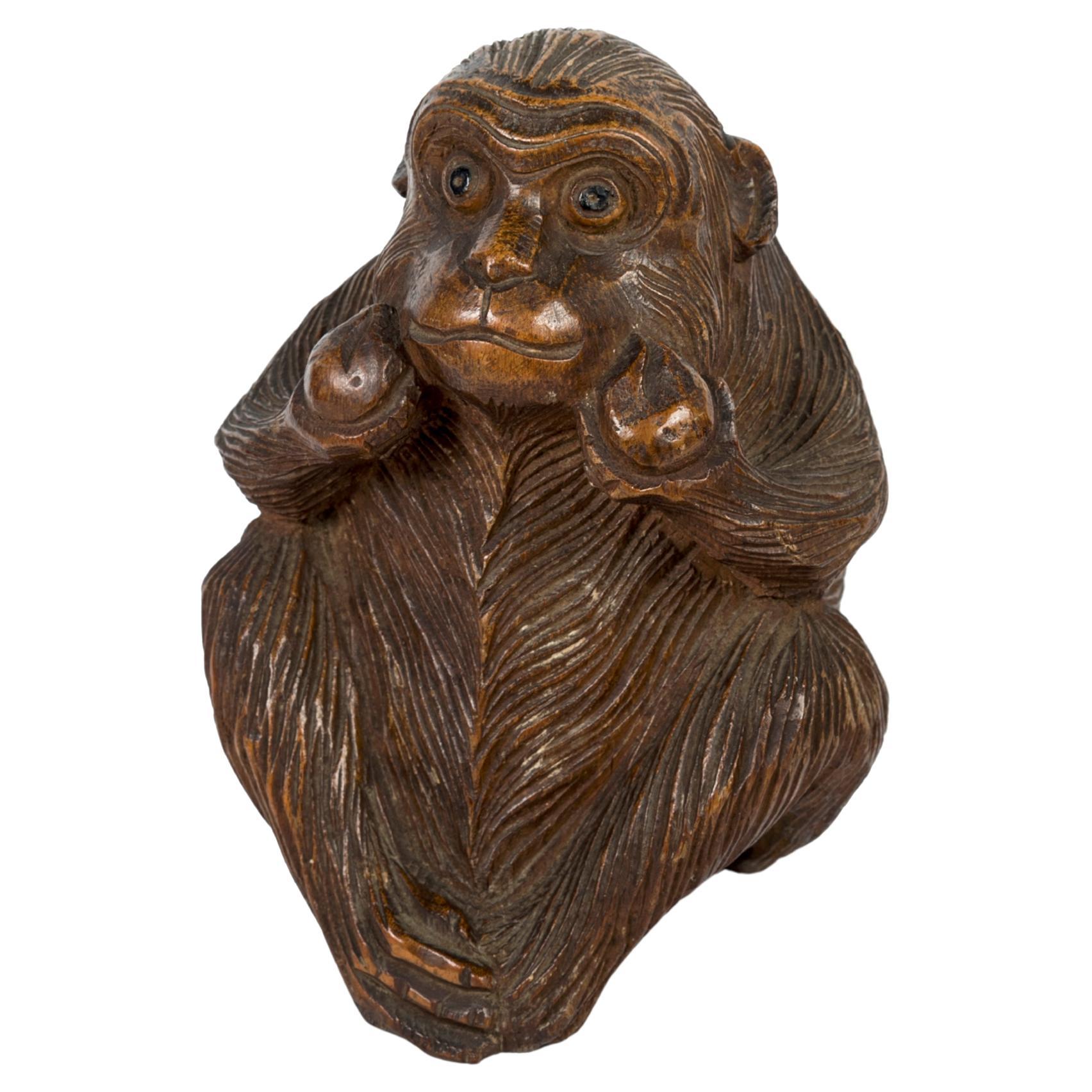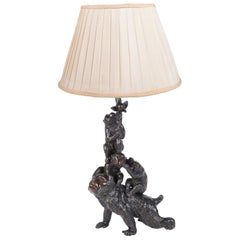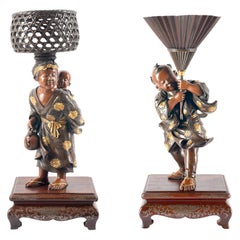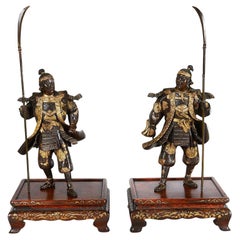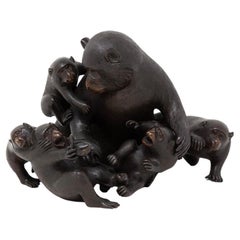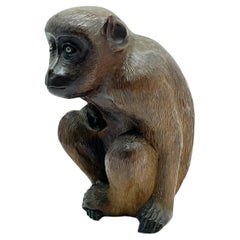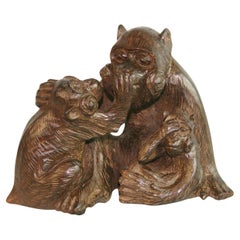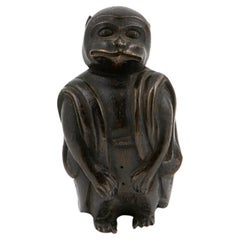Items Similar to Meiji period Japanese bronze Monkeys.
Want more images or videos?
Request additional images or videos from the seller
1 of 8
Meiji period Japanese bronze Monkeys.
$4,431.78
£3,200
€3,763.92
CA$6,029.10
A$6,699.66
CHF 3,510.69
MX$82,159.34
NOK 44,776.82
SEK 42,124.39
DKK 28,092.32
Shipping
Retrieving quote...The 1stDibs Promise:
Authenticity Guarantee,
Money-Back Guarantee,
24-Hour Cancellation
About the Item
These exquisite Japanese Meiji period sculptures depict two patinated bronze monkeys, showcasing the artistry and craftsmanship of the era. The larger monkey, seated with a contemplative expression, contrasts with the smaller, more playful figure standing beside it. Both are mounted on a polished hardwood stand, enhancing their elegance. The intricate detailing of their fur and facial features reflects the naturalistic style popular during the Meiji period, symbolizing the harmonious relationship between humans and nature. These pieces not only serve as decorative art but also as a testament to the cultural significance of wildlife in Japanese artistry of the time.
Signed.
Batch 84. G476/24 TNYZ
- Dimensions:Height: 9.85 in (25 cm)Width: 12.21 in (31 cm)Depth: 6.7 in (17 cm)
- Materials and Techniques:Bronze,Patinated
- Place of Origin:
- Period:
- Date of Manufacture:1890
- Condition:Wear consistent with age and use. No.
- Seller Location:Brighton, GB
- Reference Number:Seller: SKU000025891stDibs: LU1227245906602
About the Seller
5.0
Platinum Seller
Premium sellers with a 4.7+ rating and 24-hour response times
1stDibs seller since 2015
494 sales on 1stDibs
Typical response time: 1 hour
Associations
LAPADA - The Association of Arts & Antiques Dealers
- ShippingRetrieving quote...Shipping from: Brighton, United Kingdom
- Return Policy
Authenticity Guarantee
In the unlikely event there’s an issue with an item’s authenticity, contact us within 1 year for a full refund. DetailsMoney-Back Guarantee
If your item is not as described, is damaged in transit, or does not arrive, contact us within 7 days for a full refund. Details24-Hour Cancellation
You have a 24-hour grace period in which to reconsider your purchase, with no questions asked.Vetted Professional Sellers
Our world-class sellers must adhere to strict standards for service and quality, maintaining the integrity of our listings.Price-Match Guarantee
If you find that a seller listed the same item for a lower price elsewhere, we’ll match it.Trusted Global Delivery
Our best-in-class carrier network provides specialized shipping options worldwide, including custom delivery.More From This Seller
View AllMeiji Period Bronze Study of Monkeys Playing / Lamp
Located in Brighton, Sussex
A fine quality Meiji period (1868-1912) bronze study of Monkeys playing.
Converted to a lamp.
Category
Antique 19th Century Japanese Table Lamps
Materials
Bronze
Pair of Japanese Miyao Bronze Statues, Meiji Period
By Eisuke Miyao 1
Located in Brighton, Sussex
A fine quality pair of 19th century Japanese Miyao bronze statues of a Falconer and a Samurai warrior, each in patinated bronze with gold leaf highlights....
Category
Antique Late 19th Century Japanese Figurative Sculptures
Materials
Bronze
$11,699 / set
Pair of Japanese Miyao Bronze Figures
By Zo Miyao 1
Located in Brighton, Sussex
A fine quality pair of Japanese Meiji period (1868-1912) Miyao bronze figures depicting a mother carrying her child with a wicker basket on her head, carr...
Category
Antique Late 19th Century Japanese Figurative Sculptures
Materials
Bronze
$41,292 / set
Pair Japanese Miyao bronze figures, 36cm high.
By Eisuke Miyao 1
Located in Brighton, Sussex
A fine quality pair of Japanese Meiji period 1868-1912 Miyao bronze figures of Samurai warriors, each with a wonderful patina and gilded highlights. Each mounted on hand carved hardw...
Category
Antique Late 19th Century Japanese Sculptures and Carvings
Materials
Bronze
Japanese Meiji period bronze censor.
Located in Brighton, Sussex
A very impressive and decorative Japanese Meiji period (1868-1912) bronze Censor, having wonderful stylised tree like handles either side, inset panels depicting two Geisha...
Category
Antique Late 19th Century Japanese Planters, Cachepots and Jardinières
Materials
Bronze
Meiji period bronze plaque.
Located in Brighton, Sussex
A fine quality late 19th Century (Meiji period 1868-1912) patinated and gilded bronze plaque depicting four men looking into the sky, two under a Palm tree, the other two standing next to a Tiger and holding a smoking vessel...
Category
Antique Late 19th Century Japanese Sculptures and Carvings
Materials
Bronze
$24,087
You May Also Like
Japanese Meiji Period Bronze Monkey Group Sculpture Okimono Shosai
Located in Newark, England
Featuring Seven Japanese Macaques
Form our Japanese collection, we are delighted to offer this Japanese Bronze Monkey Group by Shosai. The Japanese Bronze Group displaying a male father monkey and his infants playing around and being mischievous with Persimmon fruit. The monkeys modelled as Japanese macaque monkeys (snow monkey). The bronze okimono is beautifully patinated with a highly lifelike and naturalistic casting signed to the underside Shosai 正齊鋳. The Bronze group dates to the Meiji Period (1868-1912) circa 1885.
Japanese macaque (snow monkey) is a terrestrial Old World monkey species that is native to Japan. They are known as snow monkeys because some live in areas where snow covers the ground for long periods each year hence their nickname. No other non-human primate lives further north or in a colder climate than the snow monkey. Individuals have brownish grey fur, pinkish-red faces, and short tails. Two subspecies are known and their conservation Status is of least concern. In Japan, the species is known as Nihonzaru ニホンザル, 日本 (Japan/Nihon) and saru 猿 (monkey) to distinguish it from other primates, but the Japanese macaque is the only species of monkey in Japan.
The Japanese macaque features heavily in the religion, folklore, and art of Japan, as well as in proverbs and idiomatic expressions in the Japanese language. They are often seen in paintings, block prints and represented in all manner of carvings from Okimono to netsuke. Many of these art forms reside in the world’s most famous museums and collections, some of the most prominent pieces by artists such as Mori Sosen and Kawanabe Kyosai. In Shinto belief (Japan’s indigenous religion/nature religion) legendary mythical beasts known as raiju sometimes appeared as monkeys and kept Raijin (the god of lightning/storms) company. In another well known tale the three wise monkeys who warn people to “see no evil, hear no evil and speak no evil” can be seen depicted in relief over the door of the famous Tosho-gu shrine in Nikko.
Meiji Period was an era of Japanese history that spanned from 1868 to 1912. It was the first half of the Empire of Japan, when the Japanese people began to build a paradigm of a modern, industrialised nation state and emergent great power, influenced by Western countries and aesthetics. As a result of radically different ideas, the changes to Japan were profound and it affected the social structure, politics, economy, military, and foreign relations across the board. The period corresponded to the reign of Emperor Meiji and was preceded by the Keio era and was succeeded by the Taisho era.
Cultural Art during the Meiji Period was of particular interest to the government and they overhauled the art export market which in turn promoted Japanese arts via various world’s fairs, beginning in Vienna at the world fair in 1873. The government heavily funded the fairs and took an active role organising how Japan’s culture was presented to the world including creating a semi-public company named Kiritsu Kosho Kaisha (First Industrial Manufacturing Company). The Kiritsu Kosho Kaisha was used to promote and commercialise exports of Japanese art and established the Hakurankai Jimukyoku (Exhibition Bureau) to maintain quality standards. For the 1876 Centennial International Exhibition in Philadelphia, the Japanese government created a Centennial Office and sent a special envoy to secure space for the 30,000 items that would be displayed. The Imperial Household also took an active interest in arts and crafts, commissioning works by select artists to be given as gifts for foreign dignitaries further emphasising the high quality and importance of Japanese art. Just before the end of the 19th century in 1890, the Teishitsu Gigeiin (Artist to the Imperial Household) system was created to recognise distinguished artists. These artists were selected for their exceptionally high quality wares and talent in their own industry. Over a period of 54 years Seventy artists were appointed, amongst these were ceramicist Makuzu Kozan and cloisonné enamel artist...
Category
Antique Late 19th Century Japanese Meiji Sculptures and Carvings
Materials
Bronze
19th Century 'Meiji Period' Japanese Carved Wood Seated Monkey Sculpture
Located in North Miami, FL
19th Century (Meiji Period) Japanese hand-carved wood seated monkey. The eyes are inlaid and made of glass. The fur and details are very realistic. The piece is signed on the bottom ...
Category
Antique 19th Century Japanese Meiji Animal Sculptures
Materials
Glass, Wood
Japanese Hand Carved Monkey Family Sculpture Hear, See and Speak No Emil
Located in Douglas Manor, NY
1276 Japanese hand carved hardwood monkey family sculpture.
Fine detail.
Category
Mid-20th Century Sculptures and Carvings
Materials
Hardwood
Small Meiji Period Japanese Bronze Monkey Sculpture
Located in Kastrup, DK
Small Japanese bronze sculpture in the form of a monkey with intricate details
Finely crafted in dark-patinated bronze with a rich patina.
Dating from the Meiji period (1868-1912) o...
Category
Antique Late 19th Century Japanese Meiji Animal Sculptures
Materials
Bronze
Miniature Bronze Statue of a Monkey on a Base
Located in Los Angeles, CA
Beautiful miniature bronze statue of a monkey sitting on a base. Great addition to your table tops and interiors.
Category
Vintage 1950s French Other Animal Sculptures
Materials
Bronze
Japanese bamboo sculpture of a Monkey holding Longevity Peaches in its two hands
Located in PARIS, FR
Chiseled wood sculpture representing a seated monkey holding peaches of longevity in his hands. The impression of the fur is quite realistic, and its e...
Category
Antique Late 19th Century Japanese Meiji Sculptures and Carvings
Materials
Bamboo
